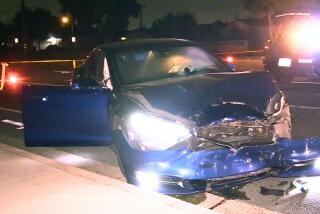Review: Tesla’s Autopilot makes for a smooth highway cruise
This week, Autopilot helped me drive a Tesla Model S luxury electric sedan from the Bay Area to Reno, about 240 miles on Interstate 80.
The next day, it helped me drive back.
Everybody I talk to wants to know: Did I like the car? Did I like Autopilot? Is it ready for prime time?
My answers: Yes, yes, and sort of.
Autopilot is the driver-assist system for the Model S. On a well-marked highway, a flick of the turn signal instructs it to change lanes automatically. It can keep a safe distance behind cars while on cruise control. It can brake for hazards. It’s among the most advanced of such systems on the market, certainly the most well-known.
It’s also kickstarted some controversy. Last May in Florida, a speeding Tesla car, Autopilot on, had its roof sheared off when the Model S failed to brake to avoid a big rig turning in its path. The driver was killed.
Before climbing aboard, I asked myself, was it just a freak accident? Could I fully trust Autopilot? I still don’t know.
But on my short run to Reno, I felt safer than if I’d driven the whole way myself, even in my most conservative Dad mode.
That feeling started about a half hour into the trip, when the BMW in front of me tried to swap lanes with a Mitsubishi next to it, both drivers oblivious. They braked hard, twisted back into their lanes, and just missed a high-speed side swipe.
Without Autopilot, I would have slammed on the brakes. But the system squeezed them with just enough pressure to create a safe distance without tossing my laptop off the passenger seat.
Otherwise, the trip was routine. I’d expected my attention to drift, but it didn’t. While cruising on Autopilot, I was happy to sit still, look forward, keep an eye on traffic, take in the scenery. It was no-stress driving, but I didn’t feel less alert.
Autopilot helped hold my attention. Every minute or two, it coaxed me to put my hands on the wheel by chiming and turning the radio down until I complied. If I didn’t grasp the wheel with at least one hand, the car would begin to slow on its way to a complete stop.
Autopilot was best in moderately heavy traffic, where you might as well lean back and let somebody else drive. Others might like it in bumper-to-bumper situations, but I was too impatient when the lane to the left of me starting moving while I crawled on Autopilot. On the open highway I don’t see much use for Autopilot; I’d rather wind out the car’s thrilling electric motor and feel the G-force.
I was nervous twice. For the first 10 minutes in the car, and then on a curvy Sierra Nevada pass, where Autopilot was taking me through a narrow lane at 60 mph with a concrete barrier a few feet to the left, a big truck to my right. My mind told me to grab the wheel, but I resisted. Autopilot handled it with agility.
I found myself using Autopilot in ways I hadn’t predicted.
The dashboard periodically reminds the driver to keep hands on the wheel, but I surrendered at times through human weakness. I sometimes turned Autopilot on specifically to deal two-handedly with some minor task: loading a podcast on my smartphone, writing down a brilliant thought, retrieving a pencil from the floor on the passenger side.
I did all this with care. When I wanted to adjust my podcast program, I’d pull into the right lane behind a steady-moving vehicle, make sure no exits were coming up, and turn on Autopilot with a couple quick lifts on a lever. I finished my task well before the warning signal chimed.
With Autopilot off, I occasionally found myself reaching for my phone to glance at a new message, which I know I’m not supposed to do, but which I often do anyway in my own car. This time, I noticed how I flicked my eyes back and forth from the road to the smartphone, over and over again, one hand on the wheel trying to stay in the lane. Dangerous, yeah, but people do it all the time. For this reason alone, I’d love to have Autopilot in my own car. Or start using Siri.
Autopilot wasn’t perfect. It seemed confused at times. It wants clear lines to follow.
At one point, in a merge situation, where a white line that was supposed to be there wasn’t, the system seemed to be thinking about what to do, moving slightly this way, slightly that. I took over the wheel and steered the car safely where I wanted it to go.
I didn’t run into any wind, but I wish I had, to test Autopilot in trickier weather conditions.
So, Autopilot’s great. I feel safer when it’s on.
Yes, you could nap. Yes, you could play catch with the kids. We don’t know exactly what happened in Florida, but the truck driver told police he heard a Harry Potter movie soundtrack from the Model S’s crumpled remains.
Consumer groups are pushing federal officials to disable Autopilot for further study. They’re requesting a name change, too, in the belief that the very word “autopliot” creates a the misconception that the car can drive all by itself, no driver needed.
So far, Tesla Chief Executive Elon Musk is sticking with the Autopilot tag. He looks at on this way: The autopilot systems for commercial aircraft require that “the pilot must be alert and prepared to take over the aircraft at any time.”
Well, yeah. But pilots are trained professionals, and the word “autopilot” means different things to different people.
Just this week, Tesla and the key contractor behind the Autopilot system broke off relations. Musk promises a new and better version to follow. Will it have a new name?







